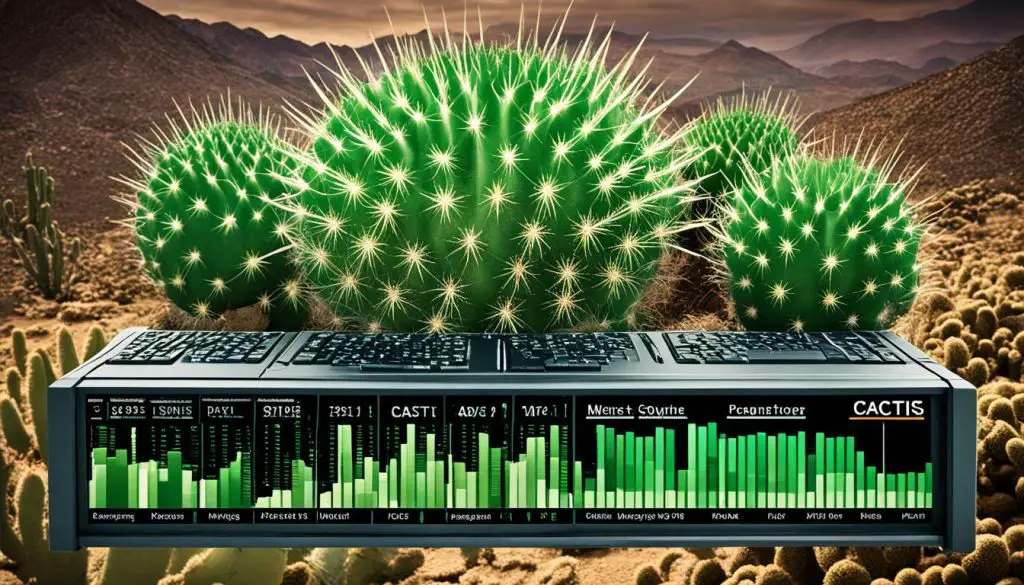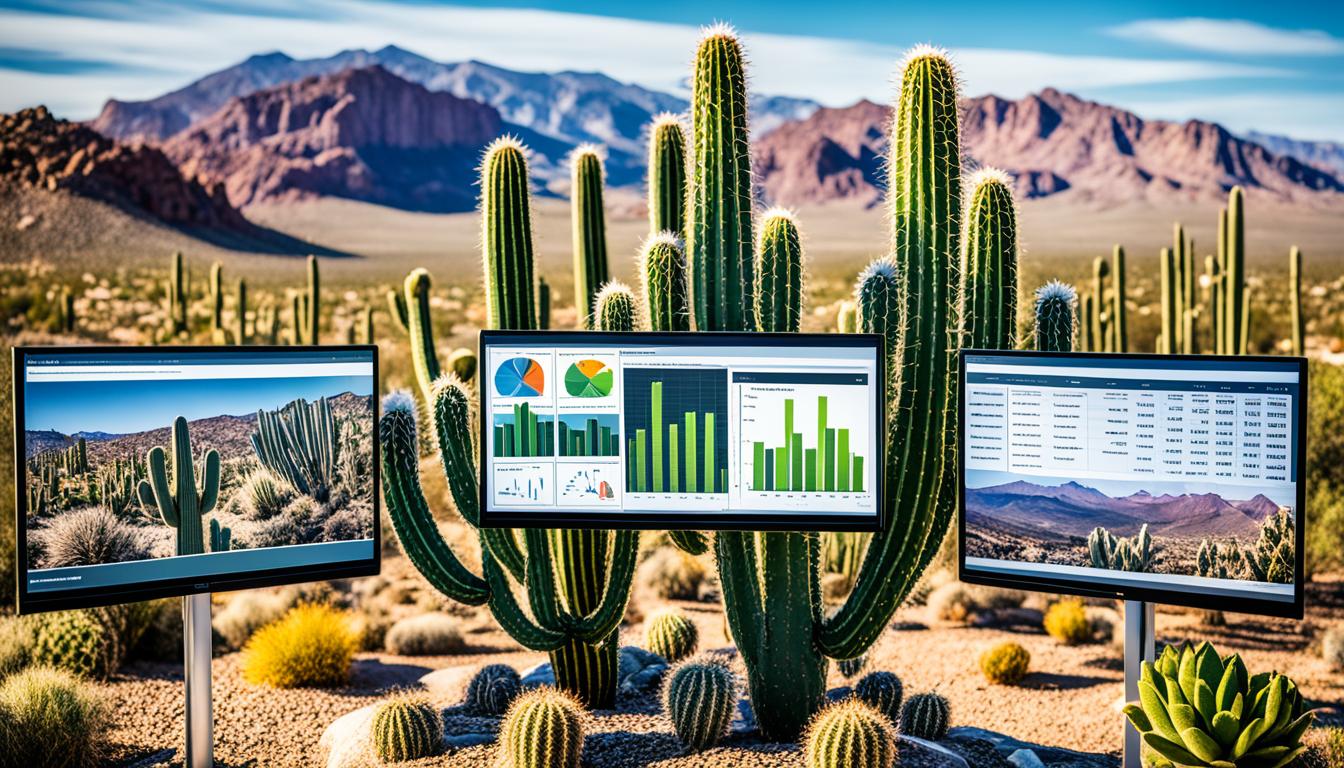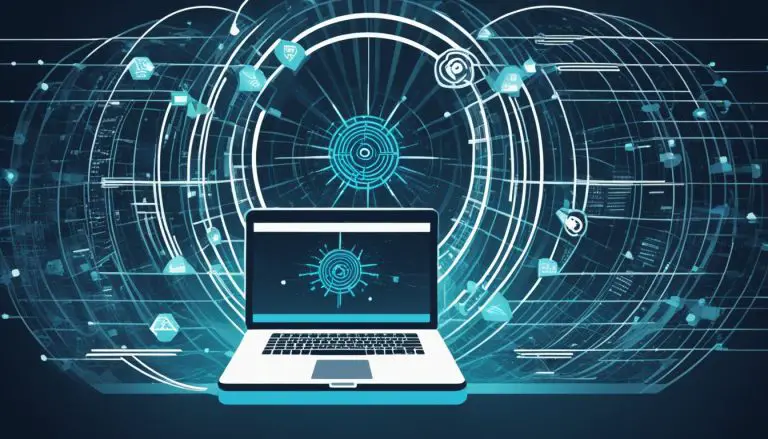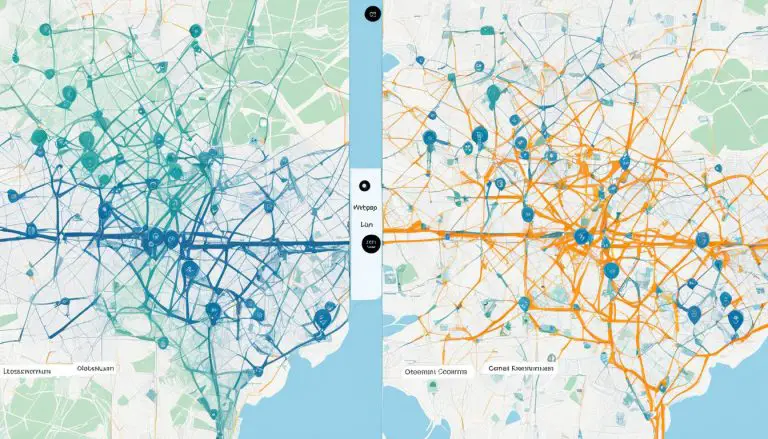Exploring What is Cacti IT-Monitoring Essentials
Have you ever wondered how businesses keep track of their IT infrastructure performance and ensure its availability and security? Look no further – Cacti IT-Monitoring is here to help! As a web-based network monitoring and graphing tool, Cacti allows real-time monitoring of network performance, providing invaluable insights into your IT environment.
But what exactly is Cacti IT-Monitoring? How does it gather and analyze data? And how can it contribute to the success of your business? Let’s delve into the essentials of this powerful network monitoring tool and discover its impact on your IT operations.
Key Takeaways:
- Cacti IT-Monitoring is a web-based network monitoring and graphing tool.
- It allows real-time monitoring of network performance.
- Cacti gathers operational information about hardware and software across the enterprise infrastructure.
- It analyzes and processes data through three fundamental layers.
- The interface layer displays analyzed data in graphs or charts.
The Importance of an IT Monitoring Strategy
An IT monitoring strategy is crucial for managing the health, performance, and availability of applications and infrastructure. It defines the purpose of monitoring, the metrics and KPIs that need to be tracked, the tools required, and how the data will be reported.
An effective IT monitoring strategy should have clear goals aligned with the overall business objectives. By identifying the specific outcomes the organization wants to achieve, such as improving application performance or reducing downtime, the strategy can prioritize the monitoring efforts and guide the selection of appropriate metrics and KPIs.
The choice of metrics and KPIs depends on the desired outcomes and the specific needs of the business. These measures should be relevant and meaningful, providing actionable insights into the performance of the IT systems. For example, if the goal is to enhance customer experience, metrics like response time, error rates, and availability would be key indicators to monitor.
To effectively implement an IT monitoring strategy, the right tools must be selected. These tools should support the collection, storage, processing, and delivery of the metrics and KPIs in a clear and actionable format. They should provide real-time monitoring capabilities, alerting IT teams when thresholds are exceeded or anomalies are detected.
Reporting plays a vital role in an IT monitoring strategy as it transforms raw data into meaningful information. The data should be presented in a way that can be easily understood and used by IT and business leaders. Reports should have clear visualizations, highlighting trends, patterns, and areas of concern. Regular reporting enables informed decision-making, assisting with capacity planning, resource allocation, and problem resolution.
“An IT monitoring strategy is like a compass that guides organizations towards achieving their IT objectives. It ensures that the right metrics are being monitored, the most appropriate tools are in place, and the data is reported in a manner that facilitates actionable insights.”
Implementing an IT monitoring strategy is not a one-time task but a continuous process. As the IT landscape evolves, new technologies and systems emerge, and business goals change, the strategy should be reviewed and adjusted to ensure its effectiveness.
Up next, let’s delve into the distinction between IT monitoring and observability to gain a deeper understanding of their importance in an IT monitoring strategy.
Monitoring vs. Observability
When it comes to IT monitoring, there is a significant distinction between monitoring and observability. While both play a crucial role in gaining insights into a system’s performance and behavior, they differ in their approach and depth of analysis.
Monitoring primarily focuses on collecting data and analyzing the outputs of applications, services, or devices. It involves tracking various metrics and trends to assess system performance and identify potential issues. Monitoring provides valuable information about the state of a system, allowing administrators to detect problems and take action accordingly.
Observability, on the other hand, takes monitoring to a whole new level. It goes beyond just collecting data and analyzing outputs. Observability provides a more holistic and detailed picture of the system’s behavior, enabling deeper insights into its internal workings. It encompasses not only metrics and trends but also the ability to explore and understand the cause and effect of events within the system.
With observability, IT professionals gain a comprehensive understanding of their system’s behavior, including the ability to pinpoint potential problems more effectively. It allows them to trace the root cause of issues and make informed decisions for proactive troubleshooting and optimization.
“Observability is about asking the right questions and having the ability to answer them accurately. It empowers IT teams to dive deeper into the system, uncover hidden patterns, and detect anomalies that may impact overall performance.”
While monitoring provides crucial insights, observability takes monitoring to the next level, bridging the gap between understanding what is happening and why it is happening. By combining the two approaches, organizations can achieve a well-rounded IT monitoring strategy that optimizes system performance, improves response times, and enhances overall efficiency.
Why are both monitoring and observability important in IT monitoring strategy?
By leveraging both monitoring and observability in an IT monitoring strategy, organizations can gain a comprehensive view of their systems and ensure maximum operational efficiency. Monitoring provides real-time data and alerts for immediate action, while observability offers a deep understanding that enables root cause analysis and proactive optimization.
For example, in an IT infrastructure environment, monitoring can help detect network latency or a sudden spike in server CPU usage. Observability, on the other hand, can provide insights into the underlying causes of these issues, such as an increase in user traffic or a misconfigured application. This holistic approach allows IT teams to address the issues more effectively and prevent them from recurring in the future.
Moreover, combining monitoring and observability in an IT monitoring strategy empowers organizations to optimize system performance, enhance user experience, and reduce downtime. It enables early detection of potential problems and the implementation of proactive measures to ensure efficient and uninterrupted operations.
In conclusion, monitoring and observability are both integral components of an effective IT monitoring strategy. While monitoring focuses on collecting data and assessing system outputs, observability provides a deeper and more comprehensive understanding of the system’s behavior. By leveraging both approaches, organizations can optimize system performance, enhance troubleshooting capabilities, and ensure maximum operational efficiency.
The Importance of an IT Monitoring Strategy
An effective IT monitoring strategy plays a critical role in the smooth operation of any business’s IT infrastructure. It ensures uninterrupted operations, maintains data integrity, and safeguards against potential cyber threats. In today’s digital era, where almost every modern enterprise relies on applications and data running on IT systems, it is essential to have a well-defined monitoring strategy to ensure application availability, customer satisfaction, and ultimately drive revenue.
IT monitoring enables businesses to identify issues and bottlenecks in their IT operations before they escalate into major problems. By closely monitoring the performance and health of applications and infrastructure, organizations can proactively address potential issues and maintain optimal performance. This proactive approach helps minimize system downtime and maximize productivity, ultimately leading to improved customer satisfaction.
Application availability is crucial to the success of any business. IT monitoring helps organizations monitor the availability of their applications and quickly detect and resolve any incidents that may impact the application’s functionality or accessibility. By promptly addressing application availability issues, businesses can minimize disruptions to their operations and ensure uninterrupted service to customers.
“An IT monitoring strategy is like quality control in a traditional factory. It ensures that the company is manufacturing quality products that operate properly and are suitable for sale.” – John Smith, IT Operations Manager
Customer satisfaction directly impacts a company’s reputation and revenue. IT monitoring allows organizations to proactively identify and address any issues or performance bottlenecks that may impact the end-user experience. By continuously monitoring applications and infrastructure, businesses can ensure smooth operation, minimal downtime, and fast response times, leading to higher customer satisfaction and retention.
Revenue generation is directly tied to the availability and performance of applications and IT systems. Any disruption or downtime can result in financial losses. By implementing an IT monitoring strategy, businesses can actively prevent revenue loss by addressing issues in a timely manner and ensuring the smooth operation of revenue-generating applications and systems.
Overall, an IT monitoring strategy is a crucial component of any enterprise’s IT operations. It enables businesses to proactively monitor and manage their applications and infrastructure, ensuring application availability, customer satisfaction, and revenue generation. By implementing a robust monitoring strategy, organizations can stay one step ahead, mitigate potential risks, and maintain a competitive edge in today’s digital landscape.
Types of IT Monitoring
With the evolving nature of IT systems and infrastructure, different types of monitoring have emerged to cater to specific aspects of the technology landscape. These monitoring strategies and tools provide organizations with the necessary visibility and insights to ensure the smooth functioning of their IT environment. Let’s explore some key types of IT monitoring:
1. IT Infrastructure Monitoring
IT infrastructure monitoring focuses on tracking the performance, availability, and resource capacity of the local data center environment. It provides valuable insights into the servers, network devices, storage systems, and other critical components that make up the infrastructure. By monitoring the infrastructure, organizations can proactively identify and resolve potential issues, minimizing downtime and ensuring optimal performance.
2. Public Cloud Infrastructure Monitoring
As more businesses leverage the benefits of public cloud services, monitoring their off-premises compute environments becomes crucial. Public cloud infrastructure monitoring allows organizations to gain visibility into the servers, memory, storage, and other resources deployed in the cloud. It helps ensure the performance, availability, and security of cloud-based applications and infrastructure, enabling efficient problem resolution and resource optimization.
3. Network Monitoring
Network monitoring is essential for maintaining the performance and availability of an organization’s LAN (Local Area Network) and WAN (Wide Area Network). It involves continuous monitoring of network devices, traffic patterns, bandwidth utilization, and other parameters. By monitoring the network, organizations can detect network vulnerabilities, identify bottlenecks, and proactively troubleshoot issues, ensuring a reliable and efficient network infrastructure.
These three types of monitoring form the backbone of an effective IT monitoring strategy. Organizations may implement different tools and approaches for each type of monitoring, depending on their specific needs and requirements.
To help visualize the importance of IT monitoring, take a look at this illustrative image:

The image above provides a visual representation of IT infrastructure monitoring, one of the key types of IT monitoring discussed in this section.
Server Monitoring Tools
When it comes to server monitoring, there are various tools available in the market, each offering unique features and licensing models. Let’s take a look at some of the top server monitoring tools:
Cacti
Cacti is an open-source network monitoring and graphing tool. It allows organizations to monitor the performance of their servers and network in real-time. With its customizable graphs and intuitive interface, Cacti is a popular choice among IT professionals.
Nagios Core
Nagios Core is a free, open-source software that provides comprehensive metrics for monitoring server and network performance. Its extensive library of plugins makes it highly flexible and adaptable to different monitoring requirements.
Zabbix
Zabbix is an open-source, enterprise-scale monitoring product. It offers advanced monitoring capabilities with features like server and network monitoring, visualization, alerting, and analytics. Zabbix is widely recognized for its scalability and robustness.
Opsview
Opsview is a comprehensive system monitoring software that caters to the needs of both SMBs and enterprises. It provides a unified view of the IT environment, allowing organizations to monitor servers, applications, networks, and more from a single platform.
Paessler PRTG Network Manager
Paessler PRTG Network Manager is a versatile tool that enables monitoring from the infrastructure level to the application stack. With its wide range of sensors and intuitive interface, PRTG Network Manager helps organizations gain insights into their servers’ performance.
SolarWinds Server and Application Monitor
SolarWinds Server and Application Monitor is a comprehensive monitoring solution that offers more than 1,000 monitoring templates for various applications and systems. It provides detailed insights into server performance and application availability, enabling organizations to proactively identify and resolve issues.
Each of these server monitoring tools has its own strengths and considerations. Organizations should consider their specific requirements and choose the tool that best fits their needs. Whether it’s Cacti, Nagios, Zabbix, Opsview, Paessler PRTG Network Manager, or SolarWinds Server and Application Monitor, these tools play a crucial role in ensuring the optimal performance and availability of servers.
Conclusion
As we conclude our exploration of IT monitoring, it is evident that monitoring IT infrastructure is crucial for maintaining the performance, security, and availability of applications and data. One valuable tool for real-time network performance monitoring is Cacti IT-Monitoring. With its web-based interface and graphing capabilities, Cacti allows businesses to track their network metrics efficiently.
To ensure effective monitoring, it is essential to have a well-defined IT monitoring strategy that aligns with business goals. This strategy should include the appropriate metrics, tools, and reporting mechanisms that meet the organization’s requirements. By selecting the right monitoring solutions and defining clear objectives, companies can effectively monitor and manage their IT environments.
There are different types of IT monitoring to consider, including IT infrastructure monitoring, public cloud infrastructure monitoring, and network monitoring. Each type focuses on specific aspects of the IT environment and requires specialized tools to provide comprehensive insights. It is crucial for organizations to choose the right server monitoring tools that best suit their needs, such as Cacti, Nagios, Zabbix, Opsview, Paessler PRTG Network Manager, or SolarWinds Server and Application Monitor.
In conclusion, implementing a robust IT monitoring strategy and utilizing reliable server monitoring tools are critical for maintaining the health and performance of an organization’s IT infrastructure. By leveraging tools like Cacti IT-Monitoring and selecting the right server monitoring solutions, businesses can proactively identify and address issues, ensuring the smooth operation of their applications and services.
FAQ
What is Cacti IT-Monitoring?
What are the key features of Cacti IT-Monitoring?
Why is an IT monitoring strategy important?
What is the difference between IT monitoring and observability?
Why is an IT monitoring strategy important for businesses?
What are the types of IT monitoring?
What are some popular server monitoring tools?
Source Links
- https://www.techtarget.com/searchitoperations/The-definitive-guide-to-enterprise-IT-monitoring
- https://www.techtarget.com/searchwindowsserver/feature/On-premises-server-monitoring-tools-meet-business-needs-budget
- https://www.linkedin.com/pulse/7-best-open-source-network-monitoring-tools-ext-noc-i6dfc?trk=public_post_main-feed-card_feed-article-content
- About the Author
- Latest Posts
Mark is a senior content editor at Text-Center.com and has more than 20 years of experience with linux and windows operating systems. He also writes for Biteno.com





